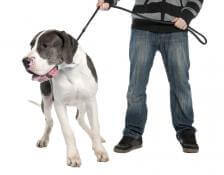The “Humane Hierarchy” in Dog Training
When your dog has a behavioral problem, what steps should your dog trainer recommend first? What techniques do ethical trainers use only as a last resort? Learn what an educated, honest trainer will and won’t recommend for your dog.

As I’ve mentioned in earlier episodes, the field of dog training and behavior modification is – well, it’s anarchy. Anybody can legally offer his services, regardless of his skills or whether he’s bothered to learn a single thing about the science of animal learning and dog behavior. Fortunately, there is a movement to set standards for education and experience – and for ethics. The Certification Council of Professional Dog Trainers has established an ethical code for trainers and behavior consultants. This week I’ll talk about the “Humane Hierarchy” – what approaches an ethical trainer takes as a first resort, and which ones lie deep in our back pockets, if we use them at all.
Health and Environment
An ethical trainer’s first stop will be your dog’s health and physical environment. Mind you, your trainer will not be making veterinary diagnoses, but she should recognize that certain behaviors or changes in behavior may signal a health problem. Sudden aggressive behavior in an old dog? She may be in pain. Frequent tiny pees indoors by a puppy who’s on a good housetraining schedule? Could be a urinary tract infection. And even if your trainer doesn’t suspect a link between a behavioral or training problem and your dog’s health, she should be alert to signs of illness or dysfunction. For instance, I’ve noticed gait and skeletal abnormalities in clients’ dogs – they might not be causing trouble now, but as Dogalini ages it may be another story.
A smart, ethical, well-educated trainer will have a big bag of dog-friendly training and behavior-change techniques.
“Physical environment” is a broad term. I take it to mean everything from the ambient noise level of your neighborhood – construction sounds are a huge source of doggy stress – to where the dog stays while the guardians are out. Let’s say your dog barks all day in the yard by himself. Don’t look at me for ideas about how to punish him; I’m going to recommend that he come in, because I’ll bet a mortgage payment that he’s bored and lonely.
Circumstances and Motivation
Next, your trainer should consider what sets the behavior off and motivates it. For instance, if Zippy barks and lunges at children who approach him, Trainer Crude may recommend a hard yank on the neck every time, to punish Zippy and stop him from lunging. Trainer Smooth, on the other hand, will look for ways to change how Zippy feels about kids so his motive for barking dissolves. Trainer Smooth will also work to help you avoid situations in which Zippy flies off the handle, so that neither he nor the poor kiddies has continued bad experiences.
Making it Easy to Do the Right Thing

Rewarding Alternative Behaviors
What if Dogalini jumps up to greet people? Lose the knee-in-the-chest routine! A good trainer will show you how to set up practice sessions, graded from super-easy to more exciting and therefore more difficult, to teach her a different greeting behavior that you can live with and that she enjoys doing. Depending on your preferences and Dogalini’s personality, she might learn to greet people by sitting or standing in front of them, by milling around eagerly but keeping her feet on the floor, or even by grabbing a toy and showing it to your guest. These appealing behaviors will earn Dogalini the attention of you and your guests. While she’s learning them, they’ll likely earn her plenty of food rewards as well.
There’s a place for training approaches that are less fun for your dog, but as you see it’s pretty far down the list – after we’re sure her health is okay and her environment meets her reasonable needs; after we work on the emotions behind the behavior; after we make it easy for her to do the right thing and be rewarded, and not so easy to do the wrong thing; after we teach her a different behavior that we like better. Not all those approaches will fit every training or behavior problem, but a good trainer has a big bag of dog-friendly tools. And an ethical trainer will choose the dog-friendly tools first.
Less-Fun Techniques
The next group of techniques an ethical trainer will turn to still steer clear of rough stuff, but are no longer actually enjoyable for the dog. Their technical names are extinction, negative punishment, and negative reinforcement.

“Negative punishment” means that when the dog does something we don’t like, we take away something the dog does like. Time-outs are negative punishments often used with puppies who nip and chew on us during play. When the teeth touch skin, we take away playtime for a few moments. As the puppy figures out that teeth make playtime go away, he begins to avoid using his teeth on us.
Extinction and negative punishment seem mild, but they have drawbacks. Extinction can be extremely frustrating and distressful for some dogs. Neither technique will teach your dog what you do want, or give your dog an alternative way to meet a legitimate need. Dogs are social animals and they need attention. Chewing and nipping are part of normal puppy development. So an ethical trainer will almost never use extinction or negative punishment without also using the techniques higher up in the Humane Hierarchy.

But there exist people who train by applying continuous shock to the dog’s neck and ending the shock when the dog complies. The dog’s reward is that the shock stops. Yeah, not going there.
The Ethical Trainer’s Last Resort
What’s the last resort of an ethical trainer? It’s what most people think of as punishment – technically called “positive punishment” because you add something unpleasant to the dog’s world in order to stop a given behavior. The unpleasantness could be a yank on a choke collar, an electric shock, a knee to the groin, or anything else ugly you can think of. Punishment training is full of pitfalls. You need exquisite timing, or you wind up punishing something the dog has done after the behavior you’re trying to get rid of. You have to judge the strength of your punishment carefully. Overdoing it can cause physical and behavioral damage, but underdoing it won’t work. If you’re punishing the same behavior over and over again, then your punishment isn’t working, and even punishment-oriented trainers agree that you’ve entered the realm of abuse. And, of course, you’re still not teaching your dog what you want him to do instead.
When you’re looking to hire a trainer, ask if they’re familiar with the Humane Hierarchy. Independently accredited trainers should be, because it’s part of the ethical code we agree to when we’re certified. And I think you’ll find, as I’ve found, that the more clever and experienced a trainer is, the bigger her bag of dog-friendly tricks.
You can follow me on Twitter, where I’m Dogalini. I’m The Dog Trainer on Facebook, and you can also write to me at dogtrainer@quickanddirtytips.comcreate new email. I welcome your comments and suggestions, and though I can’t reply individually, I may use them as the basis for future articles. Thanks for reading!
Golden Retriever, Puppy Chewing Stuffed Animal, Barking Dog and Great Dane on a Leash images courtesy of Shutterstock


